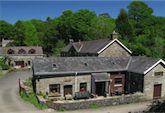Amphibians lead a double life. They are animals that can live in both water and on land. Luckily for them Plas Farm has both!
So far we have recorded the common toad and the common frog living at the farm. Although called the common frog, this species is now becoming less common in Britain, especially in rural areas. The widespread use of insecticides, and the diminishing number of breeding ponds has greatly reduced their numbers. We are very keen to find more and if you think you know a thing or two about amphibian species, then come on holiday to Wales and help us to spot them!
1. Common Frog Rana temporaria
The frog in the picture was photographed in oak woodland, a short stroll from our self catering cottages. If only it could talk! The frog’s mum lay around 2000 eggs (called frogspawn) in water somewhere on or near Plas Farm. In all likelihood, the frog in the picture is one of two to have survived to become a mature adult. After 4 weeks as an egg, it hatched into a tadpole (which look like little fish). As a tadpole it breathed oxygen from the water through a pair of gills located just behind the head. It remained in the water for a further ten weeks, feeding on plants in the water. During this time it developed front and back legs. It also gradually lost its tails, and developed lungs. At this stage of its life it looked like a mini replica of its parents, and it was now ready to leave the water and feed on land. Its diet then switched from vegetable matter to insects, slugs and worms. And then I took its photograph. And it ended up on the interent.
2. Common Toad Bufo bufo
The toad in the picture at the top of this page was spotted by two of our guests who were on a winberry picking expedition on the mountain behind our self catering cottages. Interestingly, the colour of a toad varies according to the colour of the soil in its habitat. If the soil is a greyish colour, the toads skin tends to be greyish to blend in. If the soil is more brownish, the toad tends to be more brownish. Being creatures of habit, you can often find them in the same spot week after week, but because they are able to blend in with their background, and remain motionless for hours at a time, they can be difficult to spot. A toad stalks its prey until it’s close enough to shoot its sticky tongue out and catch it. To help swallow its food, it blinks to push the food down. Although they are normally associated with water, toads and frogs spend most of their lives on dry land. They will rest in the same hiding place each day, after their nightly hunt for food. The skin of the Common Toad is cool and dry to the touch, but it contains a substance that burns the mouths of animals if they try to eat one.
The British Herpetological Society is a learned society which undertakes conservation activities to benefit amphibians and reptiles, particularly British indigenous species.
Can you tell the difference between a frog and a toad? The toad differs from the frog in a number of ways.
1. The skin of a frog is quite smooth, and a toad is more ‘warty’.
2. A frog feels moist to the touch, but a toad feels dry.
3. A frog’s back is raised with two ridges down each side. Toads have a more flattened appearance.
4. Frogs move around by hopping on their strong back legs, but toads walk.
Why not come and explore for frogs and toads at Plas Farm, holiday cottages in Wales?
